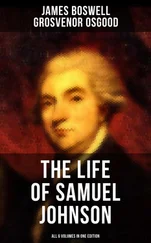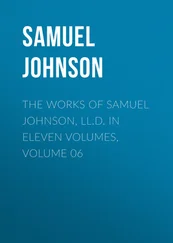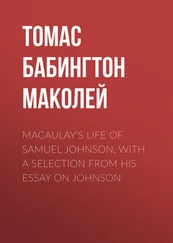James Callender - Deformities of Samuel Johnson, Selected from His Works
Здесь есть возможность читать онлайн «James Callender - Deformities of Samuel Johnson, Selected from His Works» — ознакомительный отрывок электронной книги совершенно бесплатно, а после прочтения отрывка купить полную версию. В некоторых случаях можно слушать аудио, скачать через торрент в формате fb2 и присутствует краткое содержание. Жанр: foreign_antique, foreign_prose, на английском языке. Описание произведения, (предисловие) а так же отзывы посетителей доступны на портале библиотеки ЛибКат.
- Название:Deformities of Samuel Johnson, Selected from His Works
- Автор:
- Жанр:
- Год:неизвестен
- ISBN:нет данных
- Рейтинг книги:4 / 5. Голосов: 1
-
Избранное:Добавить в избранное
- Отзывы:
-
Ваша оценка:
- 80
- 1
- 2
- 3
- 4
- 5
Deformities of Samuel Johnson, Selected from His Works: краткое содержание, описание и аннотация
Предлагаем к чтению аннотацию, описание, краткое содержание или предисловие (зависит от того, что написал сам автор книги «Deformities of Samuel Johnson, Selected from His Works»). Если вы не нашли необходимую информацию о книге — напишите в комментариях, мы постараемся отыскать её.
Deformities of Samuel Johnson, Selected from His Works — читать онлайн ознакомительный отрывок
Ниже представлен текст книги, разбитый по страницам. Система сохранения места последней прочитанной страницы, позволяет с удобством читать онлайн бесплатно книгу «Deformities of Samuel Johnson, Selected from His Works», без необходимости каждый раз заново искать на чём Вы остановились. Поставьте закладку, и сможете в любой момент перейти на страницу, на которой закончили чтение.
Интервал:
Закладка:
Readily available facts support some of the central assertions in this rather heated description of the inception of the Deformities . Specifically, as readers of Boswell's Life may recall, Johnson must be considered a – if not the – principal patron of the Scotsman William Shaw's Analysis of the Gaelic Language : he wrote the official proposals for the work, he solicited subscribers to it, and he received from the grateful author a public acknowledgement (in the "Introduction") that "To the advice and encouragement of Dr. Johnson, the friend of letters and humanity, the public is indebted for these sheets." 13 13 Life , III, 106, 107, 214, 488.
It is probable, too, that he examined the book at least cursorily 14 14 Ibid. , III, 106.
and that in doing so he caught sight of one or more of the references to Ossian's poetry, perhaps including the "specimen" on pages 145-149. Moreover, in the pamphlet Callender mentions, entitled An Enquiry into the Authenticity of the Poems Ascribed to Ossian (1781), Shaw, setting out to demolish the arguments favoring the ostensible origins of the purported translations, accords (p. 2) Johnson pride of place in starting "objections" to the poems and quotes (pp. 6-12) approvingly first a lengthy passage from A Journey to the Western Islands of Scotland (1775) and then Johnson's famous letter to James Macpherson. In addition, Boswell records Johnson's later assistance to Shaw in composing a reply to John Clark's pro-Ossian Answer to Mr. Shaw's Inquiry (1781). 15 15 Ibid. , IV, 252-253, 526.
But to admit all this is scarcely to "convict" Johnson of a deliberate " intention to deceive ." On the contrary, since by 1778 his scepticism regarding the Ossianic writings was widely known, his Journey having appeared three years earlier, it could be argued that his patronage of Shaw's Analysis revealed a degree of understanding and tolerance not always associated with his name.
For the irate Callender, however, such "shameful" conduct demanded countermeasures – even by "a private individual, without interest or connections." The self-appointed champion both of "virtue" and also of "a world … weary of" the culprit's "arrogant pedantry" and "officious malice," he hoped "to humble and reform" Johnson by "glean[ing] the tithe of" his "absurdities," which, Callender declares, illustrate, among other defects, Johnson's "prolixity," "corruptions of our language," "want of general learning," "antipathy to rival merit," "paralytick reasoning," "adherence to contradictions," "defiance of decency," and "contempt of truth" (pp. 87-88).
After garnering the supposed proofs of these multitudinous "deformities," Callender published his book at Edinburgh (where it was sold by "W. Creech") in the early part of 1782. 16 16 The work appeared well before 28 March 1782 when Johnson referred to it in the letter of Boswell cited above in note 6. In the Life (IV, 148), Boswell remarks that he had previously "informed" Johnson "that as 'The Beauties of Johnson' had been published in London, some obscure scribbler had published at Edinburgh, what he called 'The Deformities of Johnson.'"
The pamphlet, priced at a shilling and consisting of a two-page introduction and sixty-three pages of text, was also sold at London by "T. Longman, and J. Stockdale." 17 17 On p. 63, Callender calls the work "a shilling pamphlet." We are grateful to the Pierpont Morgan Library for a photographic reproduction of its copy of the first edition of the Deformities .
Towards the end of the same year (probably in December), 18 18 Since its Preface is dated 21 November 1782, the second edition was presumably published after that time but before the beginning of 1783.
encouraged by the initial "reception," he brought out a second, enlarged edition of the work, which he had "perused … with honest attention, from the first line to the last, that he might endeavour to supply its deficiencies, and to correct its errors" (p. vi). Selling for "eighteen pence" 19 19 At the end of the second edition, Callender declares: "To collect every particle of inanity which may be found in our patriot's works is infinitely beyond the limits of an eighteen-pence pamphlet" (p. 88).
and appearing at both Edinburgh and London, this edition includes a separate preface and comes to a total of eighty-nine pages. We have chosen it as the text for the present reproduction of the Deformities .
Callender's very limited powers of ridicule and exposure reside largely in his amassment of material, not in his ability to arrange and synthesize that material. Indeed, one looks in vain at the work for anything more than the most obvious and elementary form of organization. The Preface begins with brief general remarks on "man's" incapacity to "reform" his "follies" and the "prejudice" and "good nature" of the "public" respecting this human frailty, offers "Dr. Samuel Johnson" as a capital example of the general observation, proceeds to "enquire" how "such a man crawled to the summit of classical reputation," and concludes, rather abruptly, with a short postcript on the second edition of the Deformities itself. The Introduction stresses the enormous differences that, according to Callender, often exist between a man's words and deeds – particularly, so the reader is told repeatedly if a bit obliquely, between Johnson's writings (especially the Dictionary ) and actions.
The body of the pamphlet may be divided into five unequal parts. In the first (pp. 11-15), Callender launches a freewheeling attack on Johnson, accusing him of "ill-nature," a revengeful spirit, peevishness, and insolence (among other lamentable traits), and announces his chosen mode of chastisement: "From the Doctor's volumes I am to select some passages, illustrate them with a few observations, and submit them to the reader's opinion." In the second (pp. 15-47), he presents a disconnected string of quotations drawn from a number of Johnson's works and embellished with caustic strictures on their creator's presumed moral, intellectual, and literary shortcomings. In the third and longest section (pp. 47-82), separated from the second by a small printer's device, Callender, after "quoting [pp. 47-51] the remarks already made by a judicious friend, 20 20 In a footnote on p. 51, Callender tells us that the "remarks" of the "judicious friend" appear in No. 12 of the Weekly Mirror , a periodical which, according to the CBEL (II, 665, 685), was published at Edinburgh from 22 September 1780 through 23 March 1781, for a total of 26 numbers; the editor was apparently James Tytler, the publisher J. Mennons.
on this subject," begins a series of disjointed, angry comments on the supposed weaknesses of "the Doctor's English Dictionary." Thirty-one pages later, having vented his ire on the choice and definitions of hundreds of words in the Dictionary , he "take[s] leave" of the "enormous compilation," stigmatized as "perhaps … the strangest farrago which pedantry ever produced," and "return[s]" briefly, in part four (pp. 82-86; set off from part three by another small device), "to the rest of" Johnson's publications, extracts from which he again employs as a means of exhibiting his subject's supposed faults. Finally, he brings the rambling essay to a close (pp. 86-89) by recounting its origins, repeating his principal charges against Johnson, and reasserting his hopes for the Doctor's "reformation."
Although it contains some lively reading (with the author himself being the center of our interest about as often as his subject) and should certainly be readily accessible to students of eighteenth-century literature, the Deformities merits only restricted attention as a valid critique of Johnson's character and writings. Ostensibly employing, by and large, an inductive argument, it professes to demonstrate the pronounced ethical and mental flaws of the Great Cham, who enjoys, so Callender freely confesses, an unrivalled reputation among his contemporaries for his achievements in letters and lexicography. Besides the deplorable qualities mentioned above and excluding for the moment a consideration of those most evident in the Dictionary , Johnson's faults are alleged to include dishonesty, pride, vulgarity, slovenliness, dullness, contempt for other persons, prejudice (especially against the Scots), ingratitude, "gross expressions," turgid language, and, above all, ignorance, "nonsense," and countless inconsistencies. To this sweeping broadside of invective, the modern reader must respond with steady, sometimes amused, sometimes annoyed disbelief. He recognizes, to be sure, certain points of likeness between Callender's abusive imputations and (say) Boswell's highly laudatory portrait. But the former's accusations are so irresponsible and intemperate, so obviously the outburst of a quivering Scotsman's intense indignation, and the evidence adduced is so often wrenched from its context and misapplied, that the reader inevitably finds himself a partisan of Johnson even when he might be occasionally inclined to admit the tenability of Callender's criticism.
Читать дальшеИнтервал:
Закладка:
Похожие книги на «Deformities of Samuel Johnson, Selected from His Works»
Представляем Вашему вниманию похожие книги на «Deformities of Samuel Johnson, Selected from His Works» списком для выбора. Мы отобрали схожую по названию и смыслу литературу в надежде предоставить читателям больше вариантов отыскать новые, интересные, ещё непрочитанные произведения.
Обсуждение, отзывы о книге «Deformities of Samuel Johnson, Selected from His Works» и просто собственные мнения читателей. Оставьте ваши комментарии, напишите, что Вы думаете о произведении, его смысле или главных героях. Укажите что конкретно понравилось, а что нет, и почему Вы так считаете.












